Timeline of the Qing dynasty
This is a timeline of the Qing dynasty (1636–1912).
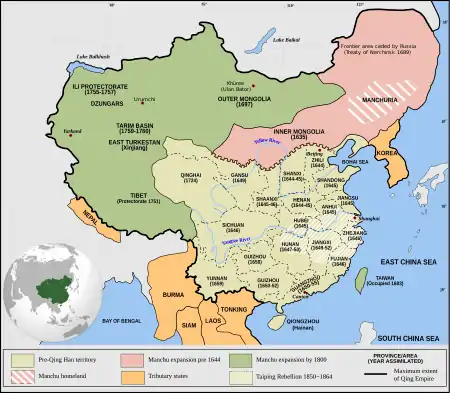
The Qing Empire ca. 1820, marked the time when the Qing began to rule these areas.
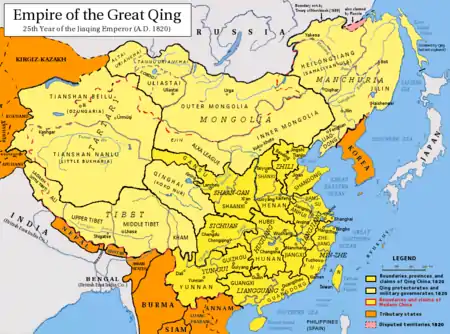
Qing Dynasty in 1820. Includes provincial boundaries and the boundaries of modern China for reference.
16th century
1580s
| Year | Date | Event |
|---|---|---|
| 1583 | Nurhaci becomes leader of the Jianzhou Left Branch[1] | |
| 1587 | Nurhaci founds Fe Ala[2] |
1590s
| Year | Date | Event |
|---|---|---|
| 1592 | Japanese invasions of Korea (1592–98): Nurhaci offers to fight the Japanese but is refused; Ming reacts with alarm to the size and quality of Nurhaci's troops[3] | |
| 1593 | Nurhaci defeats the Hulun Confederation and Khorchin Mongols[4] |
17th century
1600s
| Year | Date | Event |
|---|---|---|
| 1600 | Nurhaci creates the Banner Army[5] | |
| 1601 | Nurhaci subjugates the Hada[6] | |
| 1603 | Nurhaci and Ming generals agree to delineate the boundary between their territories[7] | |
| Nurhaci moves his capital to Hetu Ala due to water problems at Fe Ala[8] | ||
| 1605 | Gwanghaegun of Joseon sends an expedition north of the Tumen River to destroy the Jurchen Holjaon community[6] | |
| 1607 | Nurhaci subjugates the Hoifa[6] |
1610s
| Year | Date | Event |
|---|---|---|
| 1611 | Nurhaci subjugates the Wild Jurchens[9] | |
| 1613 | Nurhaci incorporates the Ula into his confederation[10] | |
| 1615 | Nurhaci increases the number of banners from four to eight[10] | |
| Nurhaci sends his last tributary emissary to Beijing[11] | ||
| 1616 | Nurhaci declares the Later Jin, also known as the Amaga Aisin Gurun[12] | |
| 1618 | 9 May | Battle of Fushun: Later Jin seizes Fushun[13] |
| summer | Battle of Qinghe: Later Jin takes Qinghe[14] | |
| 1619 | 18 April | Battle of Sarhū: Ming forces are annihilated by Later Jin[15] |
| 26 July | Battle of Kaiyuan: Later Jin takes Kaiyuan[16] | |
| 3 September | Battle of Tieling: Later Jin takes Tieling[16] | |
| September | Battle of Xicheng: Later Jin annexes the Yihe Jurchens[17] | |
| Chahar-Jurchen War: Ligdan Khan attacks Guangning, a horse trading town under the protection of Nurhaci, but is defeated[18] |
1620s
| Year | Date | Event |
|---|---|---|
| 1621 | 4 May | Battle of Shen-Liao: Later Jin seizes Shenyang[19] |
| December | Battle of Fort Zhenjiang: Ming raids into Later Jin are repulsed[20] | |
| 1622 | 11 March | Battle of Guangning: Later Jin seizes Guangning[20] |
| 1625 | Chahar-Jurchen War: Ligdan Khan's attack is turned back by a combined Khorchin Jurchen force[21] | |
| 1626 | 10 February | Battle of Ningyuan: A Later Jin attack on Ningyuan is repulsed and Nurhaci is wounded[22] |
| 30 September | Nurhaci succumbs to his wounds and dies[23] | |
| 1627 | January - March | Later Jin invasion of Joseon: Hong Taiji is elected khan and subjugates Joseon[24] |
| spring | Battle of Ning-Jin: Later Jin forces under Hong Taiji attack Jinzhou but are repelled[25] | |
| 1629 | winter | Jisi Incident: Later Jin forces break through the Great Wall and loot the region around Beijing[26] |
1630s
| Year | Date | Event |
|---|---|---|
| 1630 | summer | Jisi Incident: Later Jin forces retreat[26] |
| 1631 | 21 November | Battle of Dalinghe: Later Jin seizes Dalinghe[27] |
| 1633 | April | Wuqiao Mutiny: Shandong rebels defect to Later Jin[28] |
| summer | Siege of Lüshun: Later Jin seizes Lüshun[29] | |
| 1634 | Chahar-Jurchen War: Ligdan Khan of the Chahar Mongols is overthrown and displaced by Hong Taiji[30] | |
| 1635 | Hong Taiji unites all Jurchen tribes under the name of Manchu; so ends the Jurchens[24] | |
| Hong Taiji attacks the Hurha[31] | ||
| 1636 | April | Hong Taiji proclaims the Qing dynasty[32] |
| 9 December | Qing invasion of Joseon: Hong Taiji invades Joseon[33] | |
| 1637 | 30 January | Qing invasion of Joseon: Joseon is defeated and becomes a Qing tributary[33] |
| 1638 | Qing dynasty conquers Shandong[34] | |
| 1639 | Qing dynasty attacks the Daur and Solon people[31] |
1640s
| Year | Date | Event |
|---|---|---|
| 1640 | May | Battlgvgcge of Gualar: Qing dynasty captures the Evenk fortresses of Duochen, Asajin, Yakesa, and Duojin[31] |
| 1642 | 8 April | Battle of Song-Jin: Qing dynasty takes Jinzhou[35] |
| 1643 | Northeastern natives submit to the Qing dynasty[36] | |
| 1644 | 27 May | Battle of Shanhai Pass: Wu Sangui lets the Qingmnjn nj forces through the Great Wall and their forces defeat Li Zicheng in battle, after which Li retreats to Beijing[37] |
| 5 June | Qing dynasty takes Beijing and Li Zicheng flees[37] | |
| 1645 | January | Qing forces capture Luoyang[38] |
| 20 May | Qing forces capture Yangzhou[38] | |
| 16 June | Qing forces capture Nanjing and the Hongguang Emperor[39] | |
| 6 July | Qing forces capture Hangzhou[39] | |
| 21 July | All nonclerical adult male citizens are ordered to adopt the Manchu queue to show their allegiance to the Qing dynasty[40] | |
| 1646 | February | Ming forces are defeated in Jiangnan[41] |
| 10 July | Qing forces defeat the Ming army at Tonglu[42] | |
| 30 September | Qing forces capture Yanping[43] | |
| 6 October | The Longwu Emperor is killed by Qing forces[43] | |
| 17 October | Qing forces take Fuzhou[43] | |
| 1647 | 2 January | Zhang Xianzhong is killed by Qing forces but his army occupies Chongqing and then occupies Sichuan under the leadership of Sun Kewang[44] |
| 20 January | Qing forces capture Guangzhou and the Shaowu Emperor[45] | |
| 5 March | Qing forces conquer Guangdong, half of Guangxi, and Hainan[45] | |
| March | Qing forces take Changsha[46] | |
| spring | Qing forces raid Anping[47] | |
| 23 September | Qing forces take Wugang[48] | |
| 1648 | 20 February | Ming loyalists rebel at Nanchang and Nanning[49] |
| 14 April | Qing forces fail to take Guilin[48] | |
| 1649 | 15 January | Ming loyalists rebel at Datong[50] |
| 1 March | Qing forces take Nanchang[51] | |
| 4 October | Ming loyalists at Datong are defeated[50] | |
| summer | Qing forces conquer southern Huguang[52] | |
| 24 November | Qing forces slaughter the population of Guangzhou[53] | |
| 27 November | Qing forces capture Guilin[53] | |
| 2 December | Qing forces capture Zhaoqing and the Yongli Emperor flees[53] |
1650s
| Year | Date | Event |
|---|---|---|
| 1651 | 15 October | Qing forces capture Zhoushan and Zhu Yihai flees[54] |
| 1652 | 24 March | Battle of Achansk: Qing attack on Achansk is defeated[55] |
| 7 August | Rebel general Li Dingguo takes Guilin[56] | |
| winter | Sun Kewang's army is routed by Qing forces[56] | |
| 1654 | July | Battle of Hutong: Korean-Manchu army defeats a force of Russians[55] |
| Qing forces attack the Daur people[57] | ||
| 1655 | March-April | Siege of Komar: Qing forces fail to take Komar[55] |
| Li Dingguo's army is routed by Qing forces[56] | ||
| 1656 | 9 May | Qing forces try to invade Kinmen Island (Quemoy) but their fleet is destroyed in a storm[58] |
| Qing forces attack the Daur people[57] | ||
| 1657 | February | Ming forces defeat a Qing army near the Changjiang River Delta[58] |
| December | Sun Kewang surrenders to the Qing dynasty[59] | |
| 1658 | 10 June | Battle of Hutong (1658): Qing-Joseon forces defeat a Russian fleet on the Songhua River[55] |
| June | Zheng Chenggong occupies Wenzhou[60] | |
| 1659 | 7 January | Qing forces advance into Yunnan and the Yongli Emperor flees to Toungoo dynasty[61] |
| 10 March | Qing forces capture Yongchang and defeat Li Dingguo's army, securing Yunnan[61] | |
| 10 August | Zheng Chenggong takes Zhenjiang[62] | |
| 24 August | Zheng Chenggong lays siege to Nanjing[62] | |
| 9 September | Zheng Chenggong's army is annihilated and he retreats to Xiamen[63] |
1660s
| Year | Date | Event |
|---|---|---|
| 1660 | February | Qing forces launch an attack on Kinmen Island (Quemoy) and Xiamen but fail[63] |
| Upkeep for the Eight Banners exceeds the entire Qing dynasty's regular income[64] | ||
| 1662 | 20 January | Qing forces advance towards Inwa and force the return of the Yongli Emperor[65] |
| May | The Yongli Emperor is executed in Yunnan; so ends the Southern Ming resistance on the mainland[65] | |
| 1664 | The Qing dynasty conquers Fujian and Zheng Jing retreats to Taiwan[66] |
1670s
| Year | Date | Event |
|---|---|---|
| 1674 | Poverty in the Eight Banners is noted to be caused by excessive and extravagant spending[67] |
1680s
| Year | Date | Event |
|---|---|---|
| 1684 | The Chinese banners, "Hanjun", decline to uselessness[68] | |
| 1685 | May-July | Siege of Albazin: Qing forces take Albazin[69] |
| 1686 | July-October | Siege of Albazin: The Russians return to Albazin but the Qing forces lay siege to it again until the Russians are forced to leave[69] |
| 1689 | 27 August | Treaty of Nerchinsk: The Tsardom of Russia abandons the Amur River region to the Qing in return for trading privileges[69] |
1690s
| Year | Date | Event |
|---|---|---|
| 1690 | 3 September | Battle of Ulan Butung: Galdan Boshugtu Khan leads 20,000 troops into battle with a Qing army 300 km north of Beijing, ending with Dzungar withdrawal[70] |
| 1691 | The Khalkha Mongols submit to the Qing dynasty[71] | |
| 1696 | Battle of Jao Modo: The Qing dynasty invades Mongolia with 100,000 troops in three columns. Galdan Boshugtu Khan suffers defeat against the Western Route Army but manages to escape.[70] The Qing dynasty takes all of Mongolia from the Dzungar Khanate[71] | |
| 1698 | Dzungar–Qing Wars: Qing dynasty occupies Hami[72] |
18th century
1720s
| Year | Date | Event |
|---|---|---|
| 1720 | Chinese expedition to Tibet (1720): The Qing dynasty expels the Dzungars from Tibet, beginning the period of Tibet under Qing rule[73] | |
| Dzungar–Qing Wars: Amin Khoja leads a rebellion in Turpan against the Dzungar Khanate and defects to the Qing dynasty[72] | ||
| 1723 | The government starts investing in the Eight Banners' livelihoods to reduce their reliance on state subsidies[74] | |
| 1727 | The government orders the comprehensive collection of genealogical tables for the Eight Banners[75] | |
| 1728 | 25 June | Treaty of Kyakhta (1727): The Mongolian border of the Qing dynasty and Empire of Russia is delineated[76] |
1730s
| Year | Date | Event |
|---|---|---|
| 1732 | Dzungar–Qing Wars: The Dzungars attack Amin Khoja, who takes his people to settle in Guazhou[72] | |
| 1735 | Miao Rebellion: Qing forces defeat and massacre 28,900 Miao and Kam people in Rongjiang[77] | |
| Military upkeep reaches 32 million taels, a bit more than half of the empire's budget[78] | ||
| 1737 | Dzungar–Qing Wars: Abuse by the Dzungars cause residents of the Tarim Basin to flee to the Qing dynasty[79] |
1740s
| Year | Date | Event |
|---|---|---|
| 1742 | Bannermen of Chinese origin who joined after 1644 are allowed to leave the banner system[80] |
1750s
| Year | Date | Event |
|---|---|---|
| 1754 | Dzungar–Qing Wars: The Dörbet and Amursana defect to the Qing dynasty[81] | |
| State investment programs for the Eight Banners end[82] | ||
| Chinese bannermen at the Fuzhou, Guangzhou, Hangzhou, and Jingkou garrisons are "let go" and "excused" from their duties[80] | ||
| 1755 | Dzungar–Qing Wars: The Qing dynasty sends 50,000 troops in two columns against the Dzungars, meeting little resistance, and complete the destruction of the khanate in just 100 days, however Amursana revolts in the aftermath[72] | |
| 1756 | All secondary status households in the Eight Banners are ordered to register as civilians[83] | |
| 1757 | Dzungar–Qing Wars: Amursana flees the Qing dynasty, dying in Tobolsk[81] | |
| Chinese bannermen in Beijing who are too old, maimed, or incompetent are let go[84] |
1760s
| Year | Date | Event |
|---|---|---|
| 1760 | The government spends 4 million taels buying back land from Han owners for the Eight Banners[85] | |
| 1761 | Chinese bannermen at Suiyuan are replaced by Mongols and Manchus[84] | |
| 1762 | All Chinese bannermen are given the choice of leaving the banner system[84] | |
| 1763 | Chinese bannermen at Liangzhou and Zhuanglang are let go[84] |
19th century
1820s
| Year | Date | Event |
|---|---|---|
| 1820 | Poverty becomes endemic in the Eight Banners[86] |
1840s
| Year | Date | Event |
|---|---|---|
| 1841 | Ding Gongchen builds China's first steam engine[87] | |
| 1842 | 29 August | The Treaty of Nanking is signed between Britain and China, to come into effect on 26 June 1843. |
1890s
| Year | Date | Event |
|---|---|---|
| 1898 | 11 June | The Guangxu Emperor begins the Hundred Days' Reform[89] |
| 5 September | Zhang Yuanji recommends ending Manchu-Han differences and dissolving the Eight Banners system[90] | |
| 21 September | Empress Dowager Cixi puts the Guangxu Emperor under house arrest[91] | |
| 22 September | Empress Dowager Cixi comes to power[92] |
20th century
1900s
| Year | Date | Event |
|---|---|---|
| 1900 | June | Boxer Rebellion: Empress Dowager Cixi declares war on foreign powers[92] |
| 14 August | Boxer Rebellion: Foreign troops enter Beijing[93] | |
| 7 September | Boxer Rebellion: The Boxer Protocol is signed[94] | |
| 17 September | Boxer Rebellion: Foreign troops leave Beijing[94] | |
| 1901 | July | The Zongli Yamen is replaced with the Ministry of Foreign Affairs[95] |
| 1902 | 7 January | Empress Dowager Cixi returns to Beijing[94] |
| 1 February | Ban on intermarriage between Manchus and Han Chinese is lifted[96] | |
| 1903 | 29 December | Manchu monopoly on posts in the Eight Banners is abolished[96] |
| 1905 | 16 July | The government issues an edict proclaiming the need for leading officials to investigate new ways of government from abroad[97] |
| 24 September | Anti-Manchu proponent Wu Yue fails to assassinate the constitutional study commissioners[98] | |
| The prohibition on transfer of property from the Eight Banners to civilians is lifted[95] | ||
| 1906 | 1 September | Empress Dowager Cixi promises to form a constitutional government with no specified date[99] |
| 1907 | April | The territories of Manchuria are reorganized into provinces[95] |
| 6 July | Anhui governor Enming is assassinated by the anti-Manchu Xu Xilin[100] | |
| 20 September | Empress Dowager Cixi declares her intention to create "a bicameral deliberative body"[101] | |
| 27 September | An edict is passed to disband provincial banner garrisons over a 10 year period[102] | |
| 9 October | An edict is passed to create a set of codes which apply uniformly to Manchus and Han Chinese[101] |
Gallery
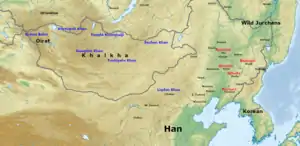 Major Mongol and Jurchen rulers on the eve of the Jurchen unification and conquest (early 17th century)
Major Mongol and Jurchen rulers on the eve of the Jurchen unification and conquest (early 17th century)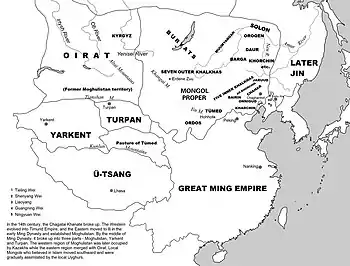 Mainland East Asia in 1616
Mainland East Asia in 1616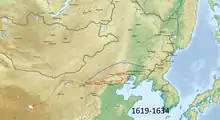 Chahar-Jurchen War (1619-1634)
Chahar-Jurchen War (1619-1634).jpg.webp) Battle of Sarhū (1619)
Battle of Sarhū (1619)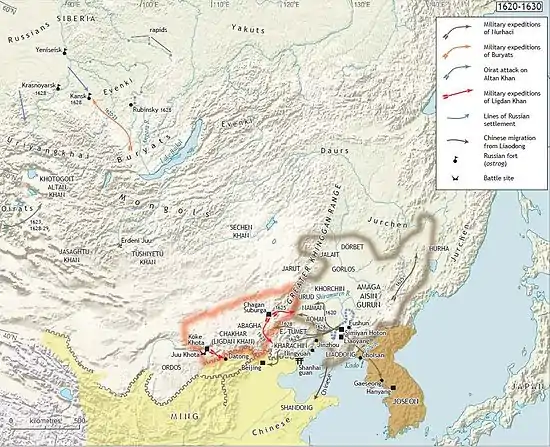 Northeast Asia (1620-1630)
Northeast Asia (1620-1630)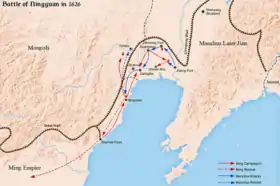 Battle of Ningyuan in 1626
Battle of Ningyuan in 1626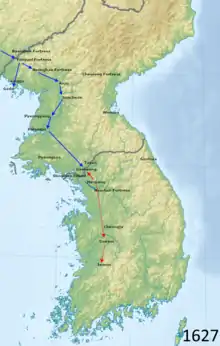 Later Jin invasion of Joseon in 1627
Later Jin invasion of Joseon in 1627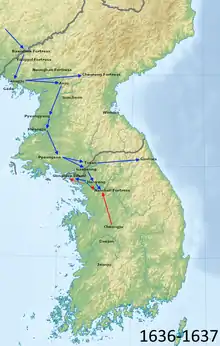 Qing invasion of Joseon in 1636
Qing invasion of Joseon in 1636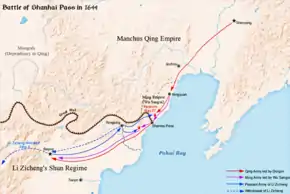 Battle of Shanhai Pass in 1644
Battle of Shanhai Pass in 1644 Southern Ming in November 1644
Southern Ming in November 1644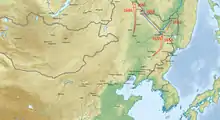 Russian-Qing border conflicts (1652-1686)
Russian-Qing border conflicts (1652-1686)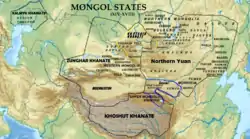 Dzungar Khanate (1634–1758) and Khoshut Khanate (1642–1717)
Dzungar Khanate (1634–1758) and Khoshut Khanate (1642–1717)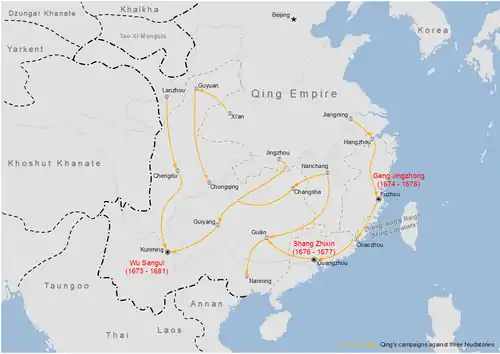 Revolt of the Three Feudatories (1673–1681)
Revolt of the Three Feudatories (1673–1681) Taiwan in the 17th century prior to the Qing conquest in 1683
Taiwan in the 17th century prior to the Qing conquest in 1683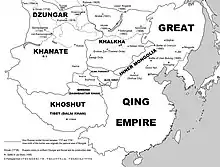 Mainland East Asia in 1688
Mainland East Asia in 1688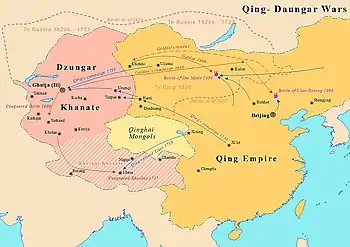 Dzungar–Qing Wars (1687–1757)
Dzungar–Qing Wars (1687–1757)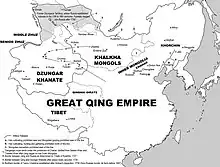 Mainland East Asia in 1757
Mainland East Asia in 1757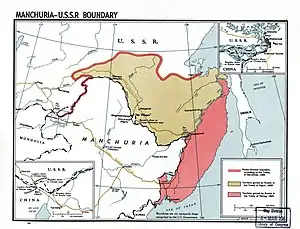 Changes in Russian-Chinese borders from the Treaty of Nerchinsk in 1689 to the Convention of Peking in 1860
Changes in Russian-Chinese borders from the Treaty of Nerchinsk in 1689 to the Convention of Peking in 1860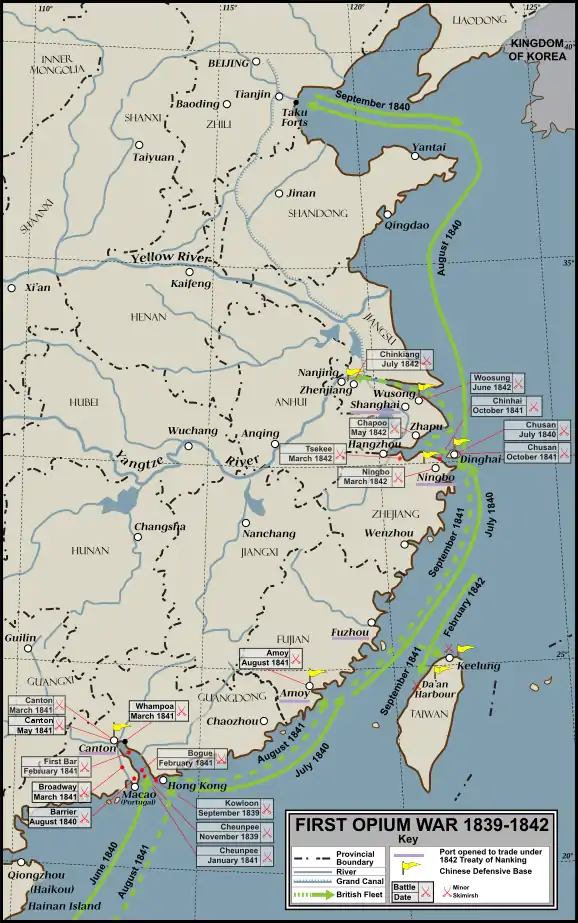 First Opium War (1839–1842)
First Opium War (1839–1842).png.webp) Taiping Rebellion (1850– 1864)
Taiping Rebellion (1850– 1864)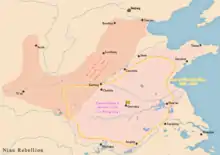 Nian Rebellion (1851–1868)
Nian Rebellion (1851–1868)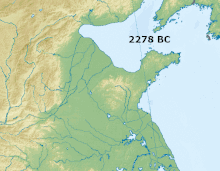 Yellow River course change in 1855
Yellow River course change in 1855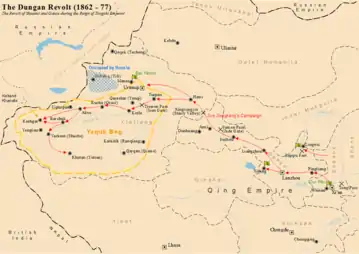
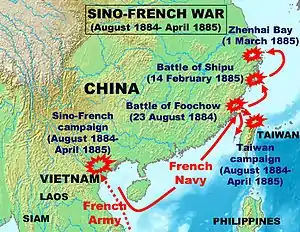 Sino-French War (1884–1885)
Sino-French War (1884–1885)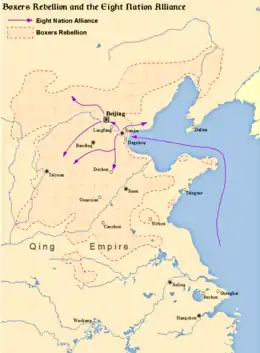 Boxer Rebellion (1900-1901)
Boxer Rebellion (1900-1901)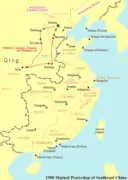
References
- Elliott 2001, p. 52.
- Elliott 2001, p. 54.
- Twitchett 1998, p. 576.
- Narangoa 2014, p. 24.
- Swope 2014, p. 19.
- Narangoa 2014, p. 25.
- Twitchett 1998, p. 570.
- Crossley 1997, p. 65-77.
- Elliott 2001, p. 56.
- Narangoa 2014, p. 28.
- Twitchett 1998, p. 558.
- Twitchett 1998b, p. 271.
- Twitchett 1998, p. 577.
- Swope 2014, p. 14.
- Twitchett 1998, p. 579.
- Wakeman 1985, p. 63.
- Swope 2014, p. 24.
- Narangoa 2014, p. 30.
- Twitchett 1998, p. 600.
- Twitchett 1998, p. 601.
- Narangoa 2014, p. 34.
- Twitchett 1998, p. 602.
- Crossley 1997, p. 74.
- Elliott 2001, p. 63.
- Swope 2014, p. 79.
- Twitchett 1998, p. 616.
- Twitchett 1998, p. 617.
- Twitchett 1998, p. 618.
- Swope 2014, p. 102.
- Crossley 1997, p. 77.
- Narangoa 2014, p. 37.
- Twitchett 1998, p. 629.
- Swope 2014, p. 115.
- Twitchett 1998, p. 630.
- Twitchett 1998, p. 636.
- Narangoa 2014, p. 41.
- Twitchett 1998, p. 639.
- Twitchett 1998, p. 656.
- Twitchett 1998, p. 660.
- Twitchett 1998, p. 662.
- Twitchett 1998, p. 673.
- Twitchett 1998, p. 675.
- Twitchett 1998, p. 676.
- Twitchett 1998, p. 702.
- Twitchett 1998, p. 679.
- Twitchett 1998, p. 682.
- Twitchett 1998, p. 712.
- Twitchett 1998, p. 683.
- Twitchett 1998, p. 684.
- Twitchett 1998, p. 691.
- Twitchett 1998, p. 686.
- Twitchett 1998, p. 690.
- Twitchett 1998, p. 692.
- Twitchett 1998, p. 698.
- Narangoa 2014, p. 46.
- Twitchett 1998, p. 704.
- Narangoa 2014, p. 47.
- Twitchett 1998, p. 718.
- Twitchett 1998, p. 706.
- Twitchett 1998, p. 719.
- Twitchett 1998, p. 707.
- Twitchett 1998, p. 720.
- Twitchett 1998, p. 721.
- Elliott 2001, p. 307.
- Twitchett 1998, p. 710.
- Twitchett 1998, p. 725.
- Elliott 2001, p. 315.
- Elliott 2001, p. 335.
- Narangoa 2014, p. 56.
- Adle 2003, p. 148.
- Adle 2003, p. 219.
- Adle 2003, p. 200.
- Adle 2003, p. 149.
- Elliott 2001, p. 318.
- Elliott 2001, p. 326.
- Christian 2018, p. 182.
- Geary 2003, p. 13.
- Elliott 2001, p. 309.
- Adle 2003, p. 199.
- Elliott 2001, p. 340.
- Adle 2003, p. 150.
- Elliott 2001, p. 321.
- Elliott 2001, p. 333.
- Elliott 2001, p. 341.
- Elliott 2001, p. 316.
- Elliott 2001, p. 322.
- Andrade 2016, p. 264.
- Elliott 2001, p. 311.
- Rhoads 2000, p. 63.
- Rhoads 2000, p. 65.
- Rhoads 2000, p. 67.
- Rhoads 2000, p. 71.
- Rhoads 2000, p. 72.
- Rhoads 2000, p. 73.
- Rhoads 2000, p. 77.
- Rhoads 2000, p. 76.
- Rhoads 2000, p. 96.
- Rhoads 2000, p. 97.
- Rhoads 2000, p. 100.
- Rhoads 2000, p. 104.
- Rhoads 2000, p. 118.
- Rhoads 2000, p. 117.
Bibliography
- Adle, Chahryar (2003), History of Civilizations of Central Asia 5, UNESCO Publishing
- Andrade, Tonio (2008j), "Chapter 10: The Beginning of the End", How Taiwan Became Chinese: Dutch, Spanish, and Han Colonization in the Seventeenth Century, Columbia University Press
- Andrade, Tonio (2016), The Gunpowder Age: China, Military Innovation, and the Rise of the West in World History, Princeton University Press, ISBN 978-0-691-13597-7.
- Asimov, M.S. (1998), History of civilizations of Central Asia Volume IV The age of achievement: A.D. 750 to the end of the fifteenth century Part One The historical, social and economic setting, UNESCO Publishing
- Atwood, Christopher P. (2004), Encyclopedia of Mongolia and the Mongol Empire, Facts On File
- Barfield, Thomas (1989), The Perilous Frontier: Nomadic Empires and China, Basil Blackwell
- Barrett, Timothy Hugh (2008), The Woman Who Discovered Printing, Great Britain: Yale University Press, ISBN 978-0-300-12728-7 (alk. paper)
- Beckwith, Christopher I. (2009), Empires of the Silk Road: A History of Central Eurasia from the Bronze Age to the Present, Princeton University Press, ISBN 0-691-13589-4
- Beckwith, Christopher I (1987), The Tibetan Empire in Central Asia: A History of the Struggle for Great Power among Tibetans, Turks, Arabs, and Chinese during the Early Middle Ages, Princeton University Press
- Biran, Michal (2005), The Empire of the Qara Khitai in Eurasian History: Between China and the Islamic World, Cambridge Studies in Islamic Civilization, Cambridge, England: Cambridge University Press, ISBN 0521842263
- Bregel, Yuri (2003), An Historical Atlas of Central Asia, Brill
- Chase, Kenneth (2003), Firearms: A Global History to 1700, Cambridge University Press, ISBN 0-521-82274-2.
- Christian, David (2018), A History of Russia, Central Asia, and Mongolia 2
- Crossley, Pamela Kyle (1997), The Manchus, Blackwell Publishers Ltd
- Dardess, John (2012), Ming China 1368-1644 A Concise History of A Resilient Empire, Roman & Littlefield Publishers, Inc.
- Dmytryshyn, Basil (1985), Russia's Conquest of Siberia, Western Imprints, The Press of the Oregon Historical Society
- Dreyer, Edward L. (2007), Zheng He: China and the Oceans in the Early Ming Dynasty, 1405-1433, Pearson Longman
- Drompp, Michael Robert (2005), Tang China And The Collapse Of The Uighur Empire: A Documentary History, Brill
- Duyvendak, J.J.L. (1938), "The True Dates of the Chinese Maritime Expeditions in the Early Fifteenth Century", T'oung Pao, 34 (5): 341–413
- Ebrey, Patricia Buckley (1999), The Cambridge Illustrated History of China, Cambridge: Cambridge University Press, ISBN 0-521-66991-X (paperback).
- Ebrey, Patricia Buckley; Walthall, Anne; Palais, James B. (2006), East Asia: A Cultural, Social, and Political History, Boston: Houghton Mifflin, ISBN 0-618-13384-4
- Elliott, Mark C. (2001), The Manchu Way: The Eight Banners and Ethnic Identity in Late Imperial China, Stanford University Press, ISBN 9780804746847
- Fernquest, John (2006), Crucible of War: Burma and the Ming in the Tai Frontier Zone (1382-1454)
Geary, Norman (2003), The Kam People of China, RoutledgeCurzon
- Golden, Peter B. (1992), An Introduction to the History of the Turkic Peoples: Ethnogenesis and State-Formation in Medieval and Early Modern Eurasia and the Middle East, OTTO HARRASSOWITZ · WIESBADEN
- Graff, David A. (2002), Medieval Chinese Warfare, 300-900, Warfare and History, London: Routledge, ISBN 0415239559
- Graff, David Andrew (2016), The Eurasian Way of War Military Practice in Seventh-Century China and Byzantium, Routledge, ISBN 978-0-415-46034-7.
- Hao, Zhidong (2011), Macau History and Society, HKU Press, ISBN 9789888028542.
- Haywood, John (1998), Historical Atlas of the Medieval World, AD 600-1492, Barnes & Noble
- Jin, Dengjian (2016), The Great Knowledge Transcendence, Palgrave Macmillan
- Latourette, Kenneth Scott (1964), The Chinese, their history and culture, Volumes 1-2, Macmillan
- Lewis, James (2015), The East Asian War, 1592-1598: International Relations, Violence and Memory, Routledge
- Liew, Foon Ming (1996), The Luchuan-Pingmian Campaigns (1436-1449) in the Light of Official Chinese Historiography
- Lorge, Peter A. (2008), The Asian Military Revolution: from Gunpowder to the Bomb, Cambridge University Press, ISBN 978-0-521-60954-8
- Luttwak, Edward N. (2009), The Grand Strategy of the Byzantine Empire, The Belknap Press of Harvard University Press
- Mills, J.V.G. (1970), Ying-yai Sheng-lan: 'The Overall Survey of the Ocean's Shores' [1433], Cambridge: Cambridge University Press
- Millward, James (2009), Eurasian Crossroads: A History of Xinjiang, Columbia University Press
- Ming, Liew Foon (1996), The Luchuan-Pingmian Campaigns (1436-1449) in the Light of Official Chinese Historiography
- Mote, F. W. (2003), Imperial China: 900–1800, Harvard University Press, ISBN 978-0674012127
- Narangoa, Li (2014), Historical Atlas of Northeast Asia, 1590-2010: Korea, Manchuria, Mongolia, Eastern Siberia, New York: Columbia University Press, ISBN 9780231160704
- Needham, Joseph (1986), Science & Civilisation in China, V:7: The Gunpowder Epic, Cambridge University Press, ISBN 0-521-30358-3
- Rhoads, Edward J.M. (2000), Manchus & Han: Ethnic Relations and Political Power in Late Qing and Early Republican China, 1861-1928, University of Washington Press
- Rong, Xinjiang (2013), Eighteen Lectures on Dunhuang, Brill
- Schafer, Edward H. (1985), The Golden Peaches of Samarkand: A study of T'ang Exotics, University of California Press
- Shaban, M. A. (1979), The ʿAbbāsid Revolution, Cambridge: Cambridge University Press, ISBN 0-521-29534-3
- Sinor, Denis (1990), The Cambridge History of Early Inner Asia, Volume 1, Cambridge University Press
- Sima, Guang (2015), Bóyángbǎn Zīzhìtōngjiàn 54 huánghòu shīzōng 柏楊版資治通鑑54皇后失蹤, Yuǎnliú chūbǎnshìyè gǔfèn yǒuxiàn gōngsī, ISBN 957-32-0876-8
- Skaff, Jonathan Karam (2012), Sui-Tang China and Its Turko-Mongol Neighbors: Culture, Power, and Connections, 580-800 (Oxford Studies in Early Empires), Oxford University Press
- Standen, Naomi (2007), Unbounded Loyalty Frontier Crossings in Liao China, University of Hawai'i Press
- Steinhardt, Nancy Shatzman (1997), Liao Architecture, University of Hawaii Press
- Swope, Kenneth M. (2009), A Dragon's Head and a Serpent's Tail: Ming China and the First Great East Asian War, 1592-1598, University of Oklahoma Press.
- Swope, Kenneth (2014), The Military Collapse of China's Ming Dynasty, Routledge
- Twitchett, Denis C. (1979), The Cambridge History of China, Vol. 3, Sui and T'ang China, 589–906, Cambridge University Press
- Twitchett, Denis (1994), "The Liao", The Cambridge History of China, Volume 6, Alien Regime and Border States, 907-1368, Cambridge: Cambridge University Press, pp. 43–153, ISBN 0521243319
- Twitchett, Denis (1998), The Cambridge History of China Volume 7 The Ming Dynasty, 1368—1644, Part I, Cambridge University Press
- Twitchett, Denis (1998b), The Cambridge History of China Volume 8 The Ming Dynasty, 1368—1644, Part 2, Cambridge University Press
- Twitchett, Denis (2009), The Cambridge History of China Volume 5 The Sung dynasty and its Predecessors, 907-1279, Cambridge University Press
- Wakeman, Frederic (1985), The Great Enterprise: The Manchu Reconstruction of Imperial Order in Seventeenth-Century China, 1, University of California Press
- Wang, Zhenping (2013), Tang China in Multi-Polar Asia: A History of Diplomacy and War, University of Hawaii Press
- Wilkinson, Endymion (2012), Chinese History: A New Manual, Harvard University Asia Center for the Harvard-Yenching Institute
- Wilkinson, Endymion (2015). Chinese History: A New Manual, 4th edition. Cambridge, MA: Harvard University Asia Center distributed by Harvard University Press. ISBN 9780674088467.CS1 maint: ref=harv (link)
- Wills, John E. (2011), China and Maritime Europe, 1500–1800: Trade, Settlement, Diplomacy, and Missions, Cambridge University Press.
- Xiong, Victor Cunrui (2000), Sui-Tang Chang'an: A Study in the Urban History of Late Medieval China (Michigan Monographs in Chinese Studies), U OF M CENTER FOR CHINESE STUDIES, ISBN 0892641371
- Xiong, Victor Cunrui (2009), Historical Dictionary of Medieval China, United States of America: Scarecrow Press, Inc., ISBN 0810860538
- Xu, Elina-Qian (2005), HISTORICAL DEVELOPMENT OF THE PRE-DYNASTIC KHITAN, Institute for Asian and African Studies 7
- Xue, Zongzheng (1992), Turkic peoples, 中国社会科学出版社
- Yuan, Shu (2001), Bóyángbǎn Tōngjiàn jìshìběnmò 28 dìèrcìhuànguánshídài 柏楊版通鑑記事本末28第二次宦官時代, Yuǎnliú chūbǎnshìyè gǔfèn yǒuxiàn gōngsī, ISBN 957-32-4273-7
- Yule, Henry (1915), Cathay and the Way Thither: Being a Collection of Medieval Notices of China, Vol I: Preliminary Essay on the Intercourse Between China and the Western Nations Previous to the Discovery of the Cape Route, Hakluyt Society
This article is issued from Wikipedia. The text is licensed under Creative Commons - Attribution - Sharealike. Additional terms may apply for the media files.